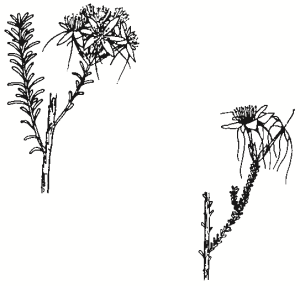Family:
Myrtaceae
Calytrix tetragona
Common Fringe-myrtle
Other Names: Fringe-myrtle, White Fringe-myrtle

Name Origin:
Calytrix — from Greek kalyx, cup and thrix, hair, referring to divisions of calyx ending in long bristly hairs.
tetragona — from Greek tetra, four, and gonia, angle, referring to leaves (when dried).
Regional Subspecies:
Occurrence:
Regional:
In most areas across region on rises and hills.
Australia:
All states except NT.
Habitat:
Heath, woodland and dry sclerophyll forest on skeletal and sandy soils.
Habit:
Bushy shrub 50 cm to 2 m high. Small aromatic green leaves 1-12 mm long and soft dark bark.
Site Preference:
Well-drained soils in full sun or semi-shade. Tolerates periodic inundation, frost and extended dry periods.
Characteristics:
Moderate growth-rate and longevity. Flammable. Highly variable in flower, leaf and habit.
Flowering:
White to pink, all year but chiefly spring.
Seed Collection:
Late Sep to mid-Mar, when capsules turn bronze and begin to fall.
Propagation:
From cuttings 4-5 cm long, taken about 3 months after flowering from young growth low down on plant. Use well-drained and aerated mix. Strike in open shade with low humidity rather than on hot bed. Unreliable from seed.
Regeneration:
From seed after light fires or when soil is bare.
VALUES:
Shade & Shelter:
Useful low-level cover in windbreaks.
Land Protection:
Colonises bare sites.
Wildlife:
Flowers are a food source for moths, butterflies and other insects. Foliage good refuge for small birds.
Ornamental:
Excellent in parks, gardens, containers, and for screens and rockeries. Particularly attractive when flowering prolifically. Prune lightly after flowering to encourage flowering and promote bushiness. Avoid planting too close to house in fire-prone areas.
